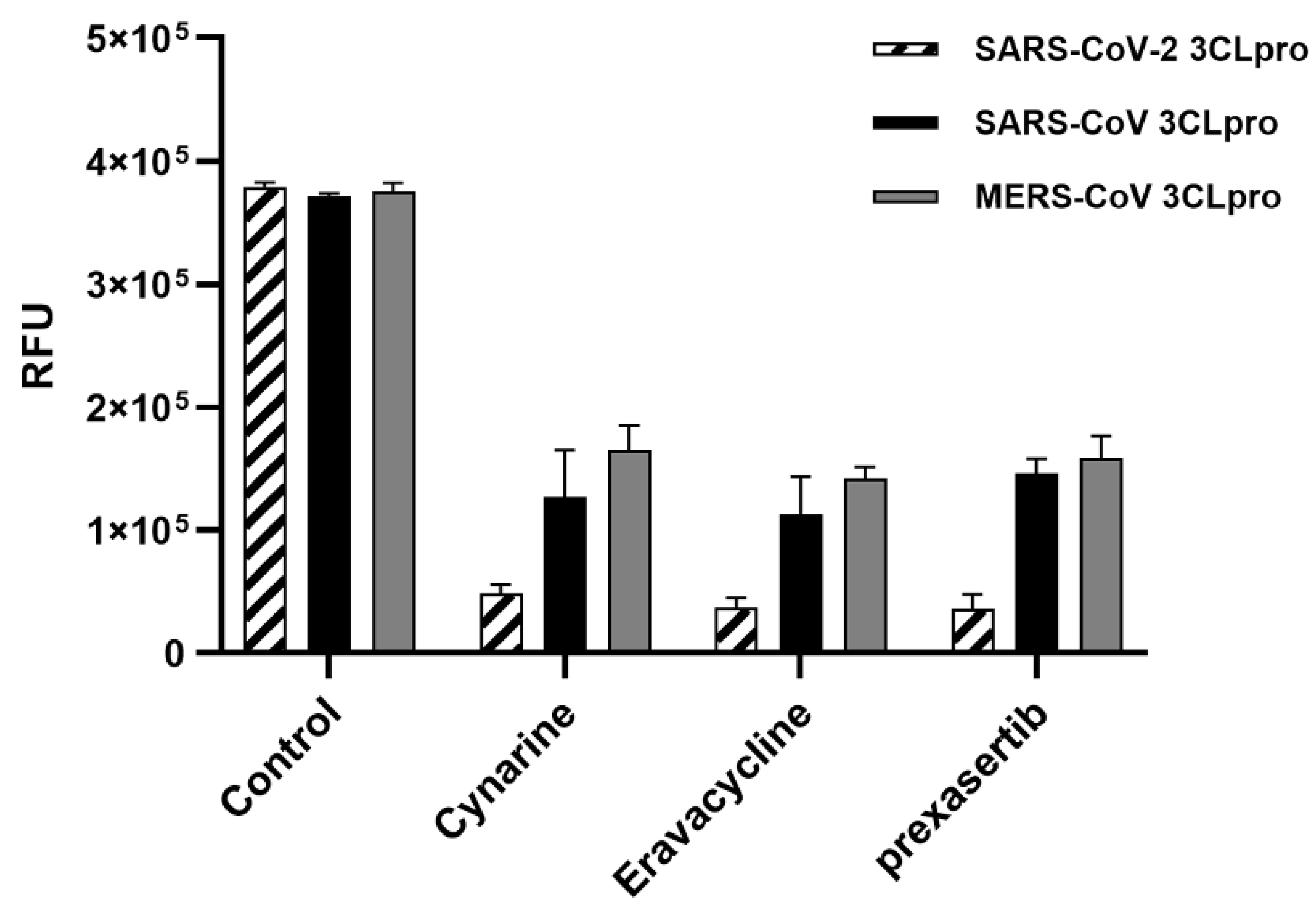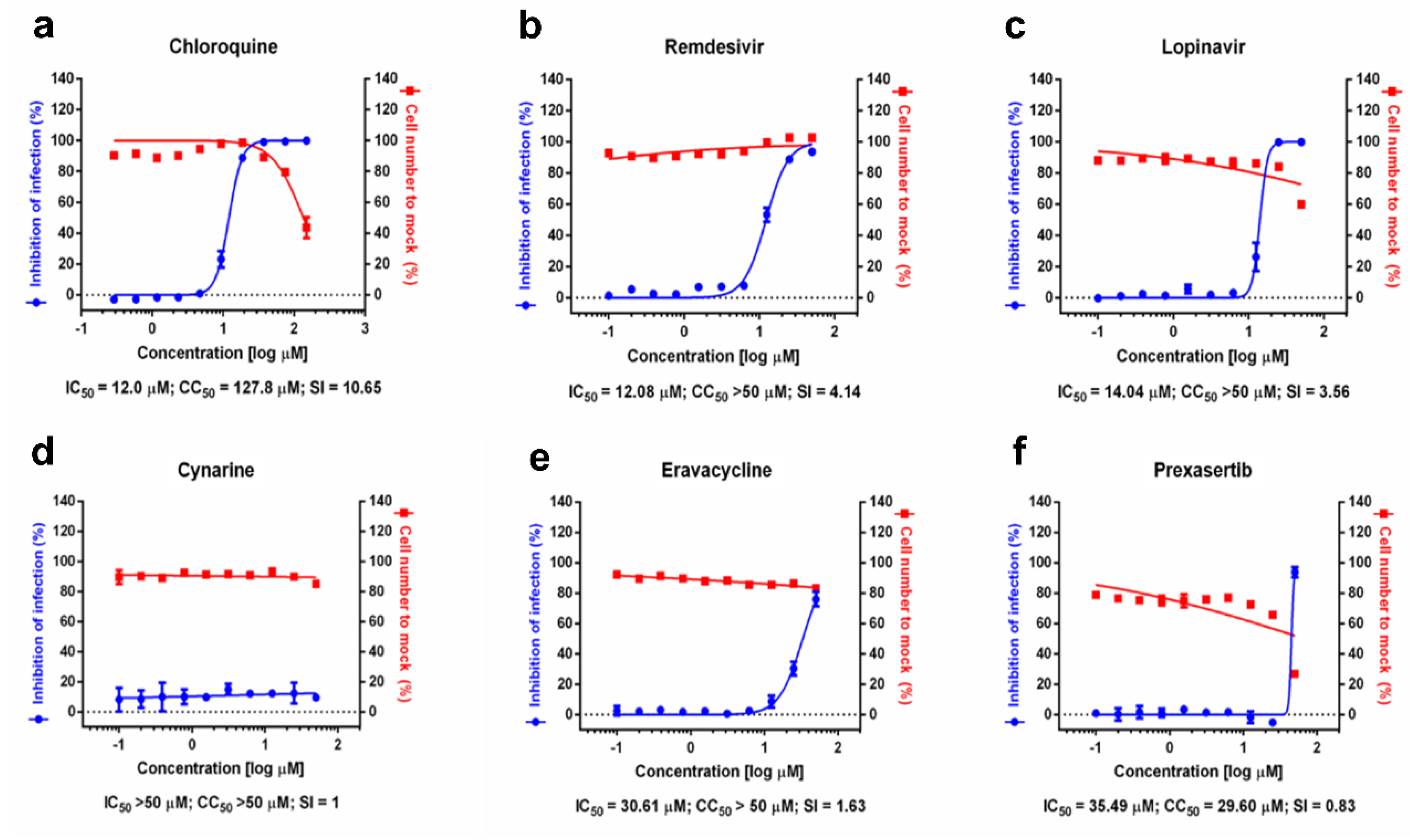A Study of Drug Repurposing to Identify SARS-CoV-2 Main Protease (3CLpro) Inhibitors
Abstract
:1. Introduction
2. Results
2.1. Identification of Potential SARS-CoV-2 3CLpro Inhibitors by Virtual Screening
2.2. Identification of Potential SARS-CoV-2 3CLpro Inhibitors by In Vitro Assay
2.3. Activity on SARS-CoV and MERS 3CL Proteases
2.4. Evaluation of Antiviral Activities of Three Compounds against SARS-CoV-2
2.5. Cell Infection Analysis by Immunofluorescent Method
3. Discussion
4. Materials and Methods
4.1. 3CLpro Protein Expression and Purification
4.2. FRET Protease Assays with SARS-CoV-2, SARS-CoV, and MERS 3CL Proteases
4.3. Compound Database
4.4. Virtual Screening for Discovery of New SARS-CoV-2 3CLpro Inhibitors
4.5. Protein and Ligand Preparation for In Silico Studies
4.6. Protein Preparation
4.7. Ligand Preparation
4.8. Docking Studies
4.8.1. Covalent Redocking
4.8.2. Non-Covalent Redocking
4.8.3. Docking of the Top-Scoring 300 Compounds
4.9. Cell Infection Analysis by Immunofluorescent Method
Supplementary Materials
Author Contributions
Funding
Institutional Review Board Statement
Informed Consent Statement
Data Availability Statement
Conflicts of Interest
Abbreviations
| 3CLpro | 3-chymotrypsin-like cysteine protease |
| DMSO | Dimethyl sulfoxide |
| DRPx | Drug repurposing |
| FRET | Fluorescence resonance energy transfer |
| MoA | Mechanism of action |
| MFs | Molecular fields |
| RNA | Ribonucleic acid |
| SD | Standard deviation |
| SP | Standard precision |
| VS | Virtual screening |
References
- Zhu, N.; Zhang, D.; Wang, W.; Li, X.; Yang, B.; Song, J.; Zhao, X.; Huang, B.; Shi, W.; Lu, R.; et al. China Novel Coronavirus Investigating and Research Team. A novel coronavirus from patients with pneumonia in China, 2019. N. Engl. J. Med. 2020, 382, 727–733. [Google Scholar] [CrossRef] [PubMed]
- Olsen, S.J.; Chen, M.-Y.; Liu, Y.-L.; Witschi, M.; Ardoin, A.; Calba, C.; Mathieu, P.; Masserey, V.; Maraglino, F.; Marro, S.; et al. Early introduction of severe acute respiratory syndrome coronavirus 2 into Europe. Emerg. Infect. Dis. 2020, 26, 1567–1570. [Google Scholar] [CrossRef] [PubMed]
- de Wit, E.; van Doremalen, N.; Falzarano, D.; Munster, V.J. SARS and MERS: Recent insights into emerging coronaviruses. Nat. Rev. Microbiol. 2016, 14, 523–534. [Google Scholar] [CrossRef] [PubMed]
- Pal, M.; Berhanu, G.; Desalegn, C.; Kandi, V. Severe Acute Respiratory Syndrome Coronavirus-2 (SARS-CoV-2): An Update. Cureus 2020, 12, e7423. [Google Scholar] [CrossRef] [Green Version]
- Deng, C.X. The global battle against SARS-CoV-2 and COVID-19. Int. J. Biol. Sci. 2020, 16, 1676–1677. [Google Scholar] [CrossRef]
- Wang, M.; Cao, R.; Zhang, L.; Yang, X.; Liu, J.; Xu, M.; Shi, Z.; Hu, Z.; Zhong, W.; Xiao, G. Remdesivir and chloroquine effectively inhibit the recently emerged novel coronavirus (2019-nCoV) in vitro. Cell Res. 2020, 30, 269–271. [Google Scholar] [CrossRef]
- Kelleni, M. Paxlovid and Molnupiravir Approved to Manage COVID-19: A Countdown for SARS CoV-2 Variant Apocalypse. OSF Prepr. 2021. [CrossRef]
- Zhang, L.; Lin, D.; Sun, X.; Curth, U.; Drosten, C.; Sauerhering, L.; Becker, S.; Rox, K.; Hilgenfeld, R. Crystal structure of SARSCoV-2 main protease provides a basis for design of improved α-ketoamide inhibitors. Science 2020, 368, 409–412. [Google Scholar] [CrossRef] [Green Version]
- Su, H.X.; Yao, S.; Zhao, W.F.; Li, M.J.; Liu, J.; Shang, W.J.; Xie, H.; Ke, C.; Hu, H.; Gao, M.; et al. Anti-SARS-CoV-2 activities in vitro of Shuanghuanglian preparations and bioactive ingredients. Acta Pharmacol. Sin. 2020, 41, 1167–1177. [Google Scholar] [CrossRef]
- Fu, L.; Ye, F.; Feng, Y.; Yu, F.; Wang, Q.; Wu, Y.; Zhao, C.; Sun, H.; Huang, B.; Niu, P.; et al. Both Boceprevir and GC376 efficaciously inhibit SARS-CoV-2 by targeting its main protease. Nat. Commun. 2020, 11, 4417. [Google Scholar] [CrossRef]
- Jin, Z.; Du, X.; Xu, Y.; Deng, Y.; Liu, M.; Zhao, Y.; Zhang, B.; Li, X.; Zhang, L.; Peng, C.; et al. Structure of Mpro from SARS-CoV-2 and discovery of its inhibitors. Nature 2020, 582, 289–293. [Google Scholar] [CrossRef] [PubMed] [Green Version]
- Morse, J.S.; Lalonde, T.; Xu, S.; Liu, W.R. Learning from the Past: Possible Urgent Prevention and Treatment Options for Severe Acute Respiratory Infections Caused by 2019-nCoV. Chembiochem 2020, 21, 730–738. [Google Scholar] [CrossRef] [PubMed]
- Corsello, S.M.; Bittker, J.A.; Liu, Z.; Gould, J.; McCarren, P.; Hirschman, J.E.; Johnston, S.E.; Vrcic, A.; Wong, B.; Khan, M.; et al. The Drug Repurposing Hub: A next-generation drug library and information resource. Nat. Med. 2017, 23, 405–408. [Google Scholar] [CrossRef] [PubMed] [Green Version]
- Kouznetsova, V.L.; Huang, D.Z.; Tsigelny, I.F. Potential SARS-CoV-2 protease Mpro inhibitors: Repurposing FDA-approved drugs. Phys. Biol. 2021, 18, 025001. [Google Scholar] [CrossRef]
- Piplani, S.; Singh, P.; Petrovsky, N.; Winkler, D.A. Computational Repurposing of Drugs and Natural Products Against SARS-CoV-2 Main Protease (Mpro) as Potential COVID-19 Therapies. Front. Mol. Biosci. 2022, 9, 781039. [Google Scholar] [CrossRef]
- Solomkin, J.; Evans, D.; Slepavicius, A.; Lee, P.; Marsh, A.; Tsai, L.; Sutcliffe, J.A.; Horn, P. Assessing the Efficacy and Safety of Eravacycline vs. Ertapenem in Complicated Intra-abdominal Infections in the Investigating Gram-Negative Infections Treated with Eravacycline (IGNITE 1) Trial: A Randomized Clinical Trial. JAMA Surg. 2017, 152, 224–232. [Google Scholar] [CrossRef]
- Connors, K.P.; Housman, S.T.; Pope, J.S.; Russomanno, J.; Salerno, E.; Shore, E.; Redican, S.; Nicolau, D.P. Phase I, open-label, safety and pharmacokinetic study to assess bronchopulmonary disposition of intravenous eravacycline in healthy men and women. Antimicrob. Agents Chemother. 2014, 58, 2113–2118. [Google Scholar] [CrossRef] [Green Version]
- Griffin, M.O.; Fricovsky, E.; Ceballos, G.; Villarreal, F. Tetracyclines: A pleitropic family of compounds with promising therapeutic properties. Review of the literature. Am. J. Physiol. Cell Physiol. 2010, 299, C539–C548. [Google Scholar] [CrossRef] [Green Version]
- Neuvonen, P.J. Interactions with the absorption of tetracyclines. Drugs 1976, 11, 45–54. [Google Scholar] [CrossRef]
- Karthikeyan, G.; Mohanraj, K.; Elango, K.P.; Girishkumar, K. Synthesis, spectroscopic characterization and antibacterial activity of lanthanide–tetracycline complexes. Transit. Metal Chem. 2004, 29, 86–90. [Google Scholar] [CrossRef]
- Parmar, K.; Kochupurakkal, B.S.; Lazaro, J.B.; Wang, Z.C.; Palakurthi, S.; Kirschmeier, P.T.; Yang, C.; Sambel, L.A.; Färkkilä, A.; Reznichenko, E.; et al. The CHK1 Inhibitor Prexasertib Exhibits Monotherapy Activity in High-Grade Serous Ovarian Cancer Models and Sensitizes to PARP Inhibition. Clin. Cancer Res. 2019, 25, 6127–6140. [Google Scholar] [CrossRef] [PubMed]
- Kirchhoff, R.; Beckers, C.; Kirchhoff, G.M.; Trinczek-Gärtner, H.; Petrowicz, O.; Reimann, H.J. Increase in choleresis by means of artichoke extract. Phytomedicine 1994, 1, 107–115. [Google Scholar] [CrossRef]
- Zaker-Esteghamati, H.; Seidavi, A.; Bouyeh, M. Effect of Cynarascolymus and its derivatives on broilers: An updated review. Anim. Biotechnol. 2020, 32, 656–662. [Google Scholar] [CrossRef] [PubMed]
- Wittemer, S.M.; Ploch, M.; Windeck, T.; Müller, S.C.; Drewelow, B.; Derendorf, H.; Veit, M. Bioavailability and pharmacokinetics of caffeoylquinic acids and flavonoids after oral administration of Artichoke leaf extracts in humans. Phytomedicine 2005, 12, 28–38. [Google Scholar] [CrossRef]
- Jo, S.; Kim, S.; Kim, D.Y.; Kim, M.S.; Shin, D.H. Flavonoids with inhibitory activity against SARS-CoV-2 3CLpro. J. Enzyme Inhib. Med. Chem. 2020, 35, 1539–1544. [Google Scholar] [CrossRef]
- Kuo, C.-J.; Chi, Y.-H.; Hsu, J.T.; Liang, P.-H. Characterization of SARS main protease and inhibitor assay using a fluorogenic substrate. Biochem. Biophys. Res. Commun. 2004, 318, 862–867. [Google Scholar] [CrossRef]
- Wu, A.; Wang, Y.; Zeng, C.; Huang, X.; Xu, S.; Su, C.; Wang, M.; Chen, Y.; Guo, D. Prediction and biochemical analysis of putative cleavage sites of the 3C-like protease of Middle East respiratory syndrome coronavirus. Virus Res. 2015, 208, 56–65. [Google Scholar] [CrossRef]
- Ma, C.; Sacco, M.D.; Hurst, B.; Townsend, J.A.; Hu, Y.; Szeto, T.; Zhang, X.; Tarbet, B.; Marty, M.T.; Chen, Y.; et al. Boceprevir, GC-376, and calpain inhibitors II, XII inhibit SARS-CoV-2 viral replication by targeting the viral main protease. Cell Res. 2020, 30, 678–692. [Google Scholar] [CrossRef]
- Morrison, J.F.; Walsh, C.T. The behavior and significance of slow-binding enzyme inhibitors. Adv. Enzymol. Relat. Areas Mol. Biol. 1988, 61, 201–301. [Google Scholar] [CrossRef]
- Musharrafieh, R.; Ma, C.; Zhang, J.; Hu, Y.; Diesing, J.M.; Marty, M.T.; Wang, J. Validating enterovirus D68-2A(pro) as an antiviral drug target and the discovery of telaprevir as a potent D68-2A(pro) inhibitor. J. Virol. 2019, 93, e0221–18. [Google Scholar] [CrossRef] [Green Version]
- Kuzmič, P.; Solowiej, J.; Murray, B.W. An algebraic model for the kinetics of covalent enzyme inhibition at low substrate concentrations. Anal. Biochem. 2015, 484, 82–90. [Google Scholar] [CrossRef]
- Kuzmič, P. DynaFit—A software package for enzymology. Methods Enzymol. 2009, 467, 247–280. [Google Scholar] [CrossRef] [PubMed]
- Artese, A.; Cross, S.; Costa, G.; Distinto, S.; Parrotta, L.; Alcaro, S.; Ortuso, F.; Cruciani, G. Molecular interaction fields in drug discovery: Recent advances and future perspectives. Wiley Interdiscip. Rev. Comput. Mol. Sci. 2013, 6, 594–613. [Google Scholar] [CrossRef]
- Lemmen, C.; Lengauer, T. Computational methods for the structural alignment of molecules. J. Comput.-Aided Mol. Design. 2000, 14, 215–232. [Google Scholar] [CrossRef] [PubMed]
- Schrödinger, LLC. Maestro; Schrödinger, LLC: New York, NY, USA, 2019. [Google Scholar]
- Sastry, G.M.; Adzhigirey, M.; Day, T.; Annabhimoju, R.; Sherman, W. Protein and ligand preparation: Parameters, protocols, and influence on virtual screening enrichments. J. Comput.-Aided Mol. Des. 2013, 27, 221–234. [Google Scholar] [CrossRef]
- Schrödinger, LLC. Prime; Schrödinger, LLC: New York, NY, USA, 2019. [Google Scholar]
- Søndergaard, C.R.; Olsson, M.H.; Rostkowski, M.; Jensen, J.H. Improved treatment of ligands and coupling effects in empirical calculation and rationalization of pK a values. J. Chem. Theory Comput. 2011, 7, 2284–2295. [Google Scholar] [CrossRef]
- Olsson, M.H.; Søndergaard, C.R.; Rostkowski, M.; Jensen, J.H. PROPKA3: Consistent treatment of internal and surface residues in empirical pKa predictions. J. Chem. Theory Comput. 2011, 7, 525–537. [Google Scholar] [CrossRef]
- Banks, J.L.; Beard, H.S.; Cao, Y.; Cho, A.E.; Damm, W.; Farid, R.; Felts, A.K.; Halgren, T.A.; Mainz, D.T.; Maple, J.R.; et al. Integrated Modeling Program, Applied Chemical Theory (IMPACT). J. Comput. Chem. 2005, 26, 1752–1780. [Google Scholar] [CrossRef] [Green Version]
- Schrödinger, LLC. LigPrep; Schrödinger, LLC: New York, NY, USA, 2019. [Google Scholar]
- Greenwood, J.R.; Calkins, D.; Sullivan, A.P.; Shelley, J.C. Towards the comprehensive, rapid, and accurate prediction of the favorable tautomeric states of drug-like molecules in aqueous solution. J. Comput.-Aided Mol. Des. 2010, 24, 591–604. [Google Scholar] [CrossRef]
- Shelley, J.C.; Cholleti, A.; Frye, L.L.; Greenwood, J.R.; Timlin, M.R.; Uchimaya, M. Epik: A software program for pKa prediction and protonation state generation for drug-like molecules. J. Comput. Aided. Mol. Des. 2007, 21, 681–691. [Google Scholar] [CrossRef]
- Zhu, K.; Borrelli, K.W.; Greenwood, J.R.; Day, T.; Abel, R.; Farid, R.S.; Harder, E. Docking covalent inhibitors: A parameter free approach to pose prediction and scoring. J. Chem. Inf. Model. 2014, 24, 1932–1940. [Google Scholar] [CrossRef] [PubMed]
- Schrödinger, LLC. Glide; Schrödinger, LLC: New York, NY, USA, 2019. [Google Scholar]




Publisher’s Note: MDPI stays neutral with regard to jurisdictional claims in published maps and institutional affiliations. |
© 2022 by the authors. Licensee MDPI, Basel, Switzerland. This article is an open access article distributed under the terms and conditions of the Creative Commons Attribution (CC BY) license (https://creativecommons.org/licenses/by/4.0/).
Share and Cite
Jo, S.; Signorile, L.; Kim, S.; Kim, M.-S.; Huertas, O.; Insa, R.; Reig, N.; Shin, D.H. A Study of Drug Repurposing to Identify SARS-CoV-2 Main Protease (3CLpro) Inhibitors. Int. J. Mol. Sci. 2022, 23, 6468. https://doi.org/10.3390/ijms23126468
Jo S, Signorile L, Kim S, Kim M-S, Huertas O, Insa R, Reig N, Shin DH. A Study of Drug Repurposing to Identify SARS-CoV-2 Main Protease (3CLpro) Inhibitors. International Journal of Molecular Sciences. 2022; 23(12):6468. https://doi.org/10.3390/ijms23126468
Chicago/Turabian StyleJo, Seri, Luca Signorile, Suwon Kim, Mi-Sun Kim, Oscar Huertas, Raúl Insa, Núria Reig, and Dong Hae Shin. 2022. "A Study of Drug Repurposing to Identify SARS-CoV-2 Main Protease (3CLpro) Inhibitors" International Journal of Molecular Sciences 23, no. 12: 6468. https://doi.org/10.3390/ijms23126468
APA StyleJo, S., Signorile, L., Kim, S., Kim, M.-S., Huertas, O., Insa, R., Reig, N., & Shin, D. H. (2022). A Study of Drug Repurposing to Identify SARS-CoV-2 Main Protease (3CLpro) Inhibitors. International Journal of Molecular Sciences, 23(12), 6468. https://doi.org/10.3390/ijms23126468




